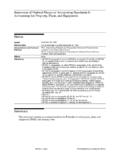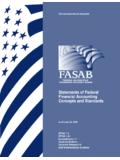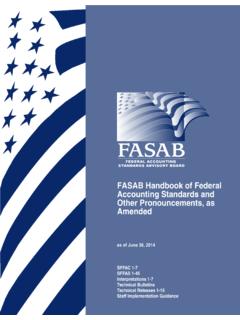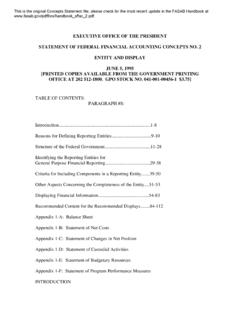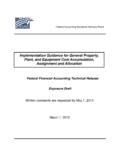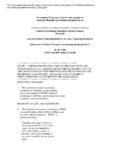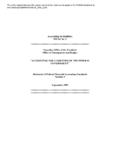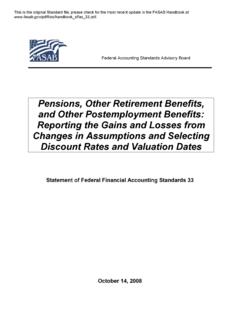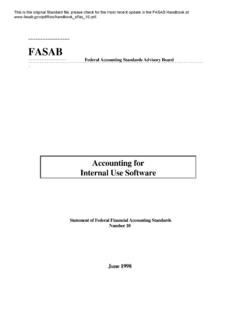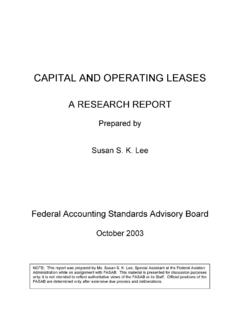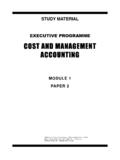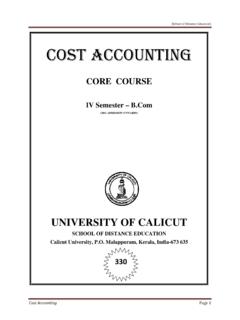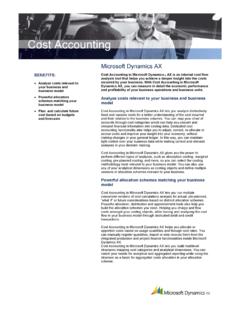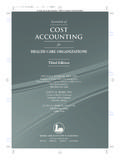Transcription of Statement #4/Managerial Cost Accounting …
1 Statement #4/Managerial cost Accounting Concepts and Standardsfor the Federal GovernmentExecutive Office of the PresidentOffice of Management and Budget"Managerial cost Accounting Concepts andStandards for the Federal Government" Statement of Federal Financial Accounting StandardsNumber 4 July 31, 1995**TABLE OF CONTNETSEXECUTIVE SUMMARY (paragraphs 1-12)INTRODUCTION (paragraphs 13-30)BackgroundUsers of Federal Government cost InformationObjectivesTerminologyMaterial ityEffective DatePURPOSES OF USING cost INFORMATION (paragraphs 31-40)Budgeting and cost ControlPerformance MeasurementDetermining Reimbursements and Setting Fees and PricesProgram EvaluationsEconomic Choice DecisionsThis is the original Standard file; please check for the most recent update in the FASAB Handbook at MANAGERIAL cost Accounting CONCEPTS (paragraphs 41-66)MANAGERIAL cost Accounting STANDARDS (paragraphs 67-162)Requirement for cost Accounting (paragraphs 67-76)Responsibility Segments (paragraphs 77-88)Full cost (paragraphs 89-104)Inter-Entity Costs (paragraphs 105-115)Costing Methodology (paragraphs 116-162)APPENDIX A: Basis for Conclusions (paragraphs 163-270)APPENDIX B: Glossary**EXECUTIVE SUMMARY1.
2 The managerial cost Accounting concepts and standards contained in this Statement are aimed at providing reliable and timely information on the full cost of federal programs, their activities, and outputs. The cost information can be used by the Congress and federal executives in making decisions about allocating federal resources, authorizing and modifying programs, and evaluating program performance. The cost information can also be used by program managers in making managerial decisions to improve operating economy and The concepts of managerial cost Accounting contained in this Statement describe the relationship among cost Accounting , financial reporting, and budgeting.
3 The five standards set forth the fundamental elements of managerial cost Accounting : (1) accumulating and reporting costs of activities on a regular basis for management information purposes, (2) establishing responsibility segments to match costs with outputs, (3) determining full costs of government goods and services, (4) recognizing the costs of goods and services provided among federalThis is the original Standard file; please check for the most recent update in the FASAB Handbook at entities, and (5) using appropriate costing methodologies to accumulate and assign costs to These standards are based on sound cost Accounting concepts and are broad enough to allow maximum flexibility for agency managers to develop costing methods that are best suited to their operational environment.
4 Also, the managerial cost Accounting standards and practices will evolve and improve as agencies gain experience in using them. The following is a summary of the concepts and standards contained in this Statement :Managerial cost Accounting Concepts4. Managerial cost Accounting should be a fundamental part of the financial management system and, to the extent practicable, should be integrated with other parts of the system. Managerial costing should use a basis of Accounting , recognition, and measurement appropriate for the intended purpose. cost information developed for different purposes should be drawn from a common data source, and output reports should be reconcilable to each cost Accounting Standards Requirement for cost accounting5.
5 Each reporting entity should accumulate and report the costs of its activities on a regular basis for management information purposes. Costs may be accumulated either through the use of cost Accounting systems or through the use of cost finding techniques. Responsibility segments6. Management of each reporting entity should define and establish responsibility segments. Managerial cost Accounting shouldThis is the original Standard file; please check for the most recent update in the FASAB Handbook at be performed to measure and report the costs of each segment's outputs. Special cost studies, if necessary, should be performed to determine the costs of outputs.
6 Full cost7. Reporting entities should report the full costs of outputs in general purpose financial reports. The full cost of an output produced by a responsibility segment is the sum of (1) the costs of resources consumed by the segment that directly or indirectly contribute to the output, and (2) the costs of identifiable supporting services provided by other responsibility segments within the reporting entity, and by other reporting entities. Inter-entity costs8. Each entity's full cost should incorporate the full cost of goods and services that it receives from other entities. The entity providing the goods or services has the responsibility to provide the receiving entity with information on the full cost of such goods or services either through billing or other Recognition of inter-entity costs that are not fully reimbursed is limited to material items that (1) are significant to the receiving entity, (2) form an integral or necessary part of the receiving entity's output, and (3) can be identified or matched to the receiving entity with reasonable precision.
7 Broad and general support services provided by an entity to all or most other entities generally should not be recognized unless such services form a vital and integral part of the operations or output of the receiving entity. Costing methodology10. Costs of resources consumed byThis is the original Standard file; please check for the most recent update in the FASAB Handbook at responsibility segments should be accumulated by type of resource. Outputs produced by responsibility segments should be accumulated and, if practicable, measured in units. The full costs of resources that directly or indirectly contribute to the production of outputs should be assigned to outputs through costing methodologies or cost finding techniques that are most appropriate to the segment's operating environment and should be followed The cost assignments should be performed using the following methods listed in the order of preference.
8 (a) directly tracing costs wherever feasible and economically practicable, (b) assigning costs on a cause- and-effect basis, or (c) allocating costs on a reasonable and consistent These Accounting standards need not be applied to items that are qualitatively and quantitatively immaterial. The Board recommends that the managerial Accounting standards of this Statement become effective for fiscal periods beginning after September 30, 1996. Earlier implementation is encouraged.**INTRODUCTIONB ackground13. Reliable information on the costs of federal programs and activities is crucial for effective management of government operations. In Statement of Federal Financial Accounting Concepts (SFFAC) No.
9 1, Objectives of Federal Financial Reporting, issued in 1993, it is stated that the objectives of federal financial reporting are to provide useful information to assist internal and external users in assessing the budget integrity, operating performance, stewardship, and systems and controlThis is the original Standard file; please check for the most recent update in the FASAB Handbook at of the federal government.[Footnote 1][Footnote 1: Statement of Federal Financial AccountingConcepts No. 1, "Objectives of Federal FinancialReporting" (September 2, 1993), pars. 110 and 111,pages 34-35.]14. Managerial cost Accounting is especially important for fulfilling the objective of assessing operating performance.
10 In relation to that objective, it is stated in SFFAC No. 1 that federal financial reporting should provide information that helps users to determine:-- Costs of specific programs and activities and the composition of, and changes in, those costs;-- Efforts and accomplishments associated with federal programs and their changes over time and in relation to costs; and-- Efficiency and effectiveness of the government's management of its assets and liabilities.[Footnote 2][Footnote 2: Ibid., pars. 126-130, pages 39-40.]15. It is further stated in SFFAC No. 1 that "Thetopics of costs and performance measurement are relatedbecause it is by associating cost withactivities or cost objectives that Accounting canmake much of its contribution to reporting onperformance.
